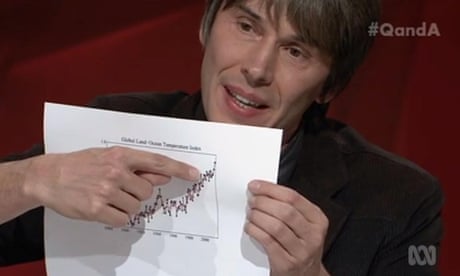As any young Earth creationist will confirm, the BBC occasionally fails in its objective of due impartiality. Only last week, it reported on a fossil find in Greenland, without bothering to balance this with a contribution from a fundamentalist Christian, such as Trump’s running mate, Mike Pence.
If the US might seem like a long way to go for comment, the BBC’s referendum coverage demonstrated that, when balance is at stake, a contributor’s passion can be quite as compelling a qualification as his or her expertise, reputation or, even, connection with the subject under discussion. Moreover, Pence has a long acquaintance with creationism.
It was never clear, at least to this listener, why Steve Hilton, a US resident who once fell out with the last prime minister, became one of the anti-EU stars of the BBC’s Brexit coverage, to the point of assisting with analysis on referendum night. But in line with BBC impartiality guidelines that are enforced, arguably to the point of misrepresentation, when the corporation feels threatened, he was no doubt balanced by a yet more embittered – but pro-Remain – ex-Cameron adviser with a similarly touristic stake in the outcome.
To be fair to Mr Hilton, he could hardly be blamed for embracing a dazzling career in EU punditry when the BBC pressed it upon him, nor was his inexplicable prominence the most bizarre or regrettable aspect of the coverage which, according to polling by the Electoral Reform Society (ERS), played the biggest part in the referendum in keeping the British public informed. Throughout a debate the ERS describes as “dire”, the BBC was the source of information most commonly cited as important. The final level of public understanding, after a four-month campaign, is well illustrated, says its new report, by the great spike on 24 June in the number of people googling “What is the EU?” “We would argue,” say the authors, “that the levels of knowledge reported by members of the public were too low throughout.” This, despite demonstrably high levels of public interest and lavish airtime for the individuals they describe as “big beasts”.
Among their recommendations for better informed plebiscites, as referendums become more commonplace, are longer campaign periods and an independent body empowered to correct misleading statements such as the untruth – holy writ according to Gisela Stuart, Michael Gove and Boris Johnson – that Britain sends a weekly £350m to the EU. Further public understanding might be achieved, it says, if broadcasters attempted more “deliberative” as opposed to tit-for-tat coverage of the type that infuriated complainants to the BBC’s Feedback programme long before they could be written off as sore losers.
If there are pointed lessons here for some BBC programme-makers, who must bear partial responsibility for the final level of public bafflement, maybe they shouldn’t be blamed for submitting to management orders, issued when the now forgotten escort fan and culture secretary, John Whittingdale, was emitting worrying noises. The EU referendum guidelines effectively ordained that BBC coverage would adhere, in the aim of impartiality, to traditional, binary practices, despite this being a non-party political debate to which any number of non-affiliated, non big beasts might have more insights to contribute than Westminster’s in-fighters. In Johnson’s case, these amounted to: “We export French knickers to France... Are the French really going to put tariffs on our French knickers when we buy so much of their cheese and their champagne? Of course they’re not!”
Questioned about the many, normally respected authorities whose research indicated more problematic economic outcomes, Johnson’s ally, Gove, urged voters to shun the Nobel laureates’ paperwork. “We have to be careful about historical comparisons, but Albert Einstein during the 1930s was denounced by the German authorities for being wrong and his theories were denounced and one of the reasons of course he was denounced was because he was Jewish. They got 100 German scientists in the pay of the government to say that he was wrong and Einstein said, ‘Look, if I was wrong, one would have been enough.’”
“For me,” writes Professor John van Reenen, formerly of the LSE, now at MIT and one of the economists thus likened by Gove to an antisemitic, government-owned Nazi, “it simply capped off a frankly disgusting campaign, one where the Leave side simply impugned the motives of ‘the experts’ rather than seriously engaging with the substance of the economic debate.”
But the Leave side might not have got away with this ugliness, nor Remain with prattling about imminent apocalypse, had not the BBC, as well as enabling an often asinine level of argument, allowed its obsession with balance to dictate that any carefully argued observation on Brexit, deserving of analysis, be promptly followed by its formal opponent’s unsubstantiated bluster.
Similarly, no more attention would be devoted to a striking near-consensus of economic opinion than to its negation by a speaker representing a groupuscule of eight. Admittedly, this was tough on the eight. Professor Patrick Minford was working hours to which no elderly economist should be subjected. But that’s just one of the costs of the BBC’s “regulated equivocation”, as its critics call a habit that has previously embarrassed the corporation when applied to climate change and the MMR. Until recently, it considered the climate change denier Nigel Lawson as fine a match for peer-reviewed research as it now believes him a trusted guarantor of post-Brexit glories, possibly forgetting his earlier history of shadowing the deutschmark.
In his 2011 report on BBC science coverage, the geneticist Professor Steve Jones criticised the “over-rigid” insistence on due impartiality that could give “undue attention to marginal opinion”. But once again, in referendum coverage, the corporation actively required its journalists to supply this phony balance, even when that meant, as Jones put it on science, allowing rhetoric – say Gove’s “hostages” in a car – “to give the appearance of debate”.
As with climate change, implicit in extreme BBC impartiality is a distinctly un-BBC like, post-truth proposal that, since all opinions merit equal coverage, the public might as well give up on evidence-based argument. So much was plainly stated by Today’s Nick Robinson when he assured voters who were, in huge numbers, seeking information from the BBC that the debate was all “claims and counterclaims”, “guesswork”. “No journalist,” he declared, “no pundit, no expert can resolve these questions for you.” Whether the imaginary £350m claimed by Johnson and Gove would ever be imaginarily spent on the NHS was not, it presumably followed, a lie for the BBC to repeatedly expose, but “a matter of judgment”.
Whichever side you were on, the BBC’s coverage was not, as the ERS is not the first to point out, such as to create unalloyed confidence in the outcome. Even the winners would discover, shortly after voting, that one big beast (Gove) had never meant it about the NHS’s £350m; that another (Hannan) saw no connection with reduced immigration. That ERS idea, the official fact checker, has already been derided as a “stuck-up quango”. But would the ERS be asking if the BBC had done its job?
In his 2011 report on BBC science coverage, the geneticist Professor Steve Jones criticised the “over-rigid” insistence on due impartiality that could give “undue attention to marginal opinion”. But once again, in referendum coverage, the corporation actively required its journalists to supply this phony balance, even when that meant, as Jones put it on science, allowing rhetoric – say Gove’s “hostages” in a car – “to give the appearance of debate”.
As with climate change, implicit in extreme BBC impartiality is a distinctly un-BBC like, post-truth proposal that, since all opinions merit equal coverage, the public might as well give up on evidence-based argument. So much was plainly stated by Today’s Nick Robinson when he assured voters who were, in huge numbers, seeking information from the BBC that the debate was all “claims and counterclaims”, “guesswork”. “No journalist,” he declared, “no pundit, no expert can resolve these questions for you.” Whether the imaginary £350m claimed by Johnson and Gove would ever be imaginarily spent on the NHS was not, it presumably followed, a lie for the BBC to repeatedly expose, but “a matter of judgment”.
Whichever side you were on, the BBC’s coverage was not, as the ERS is not the first to point out, such as to create unalloyed confidence in the outcome. Even the winners would discover, shortly after voting, that one big beast (Gove) had never meant it about the NHS’s £350m; that another (Hannan) saw no connection with reduced immigration. That ERS idea, the official fact checker, has already been derided as a “stuck-up quango”. But would the ERS be asking if the BBC had done its job?






